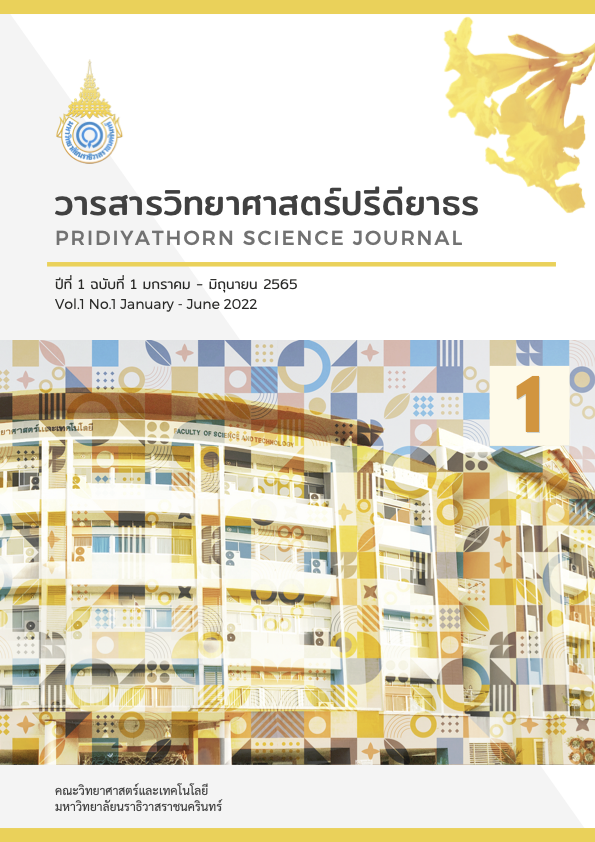Intestinal histology and Infiltration of intestinal eosinophils of the Golden tree snake Chrysopelea ornata (Shaw, 1802)
คำสำคัญ:
งูเขียวพระอินทร์, อีโอซิโนฟิลแกรนูโลไซต์, มิญชวิทยา, ลำไส้, ประเทศไทยบทคัดย่อ
การปรากฏของอีโอซิโนฟิลแกรนูโลไซต์ในกระเพาะอาหารและลำไส้ในสัตว์มีกระดูกสันหลังเกี่ยวกับการตอบสนองทางสรีรวิทยาสะท้อนถึงการอักเสบแบบเรื้อรังแต่ข้อมูลเหล่านี้ยังไม่ได้รายงานในงูเขียวพระอินทร์ Chrysopelea ornata (Shaw, 1802) ซึ่งพบได้ทั่วไปในประเทศไทย วัตถุประสงค์ของการศึกษาเพื่อบรรยายถึงมิญชวิทยาของลำไส้และการแทรกตัวของอีโอซิโนฟิลแกรนูโลไซต์ในงูเขียวพระอินทร์ด้วยเทคนิคการย้อมพิเศษ Periodic acid-Schiff (PAS) ตัวอย่างงูเขียวพระอินทร์จำนวน 3 ตัว มีขนาดความยาวลำตัวเฉลี่ยเท่ากับ 61.02±0.83 เซนติเมตร จากบริเวณเขาคอหงส์ จังหวัดสงขลา ประเทศไทย หลังจากนั้นเก็บลำไส้และนำไปผ่านกระบวนมาตรฐานทางมิญชวิทยา ผลการศึกษาพบว่างูชนิดนี้มีโครงสร้างลำไส้มีการยกตัวขึ้นและมีการจัดเรียงท่อด้วย 4 ชั้นหลัก คือ 1. ชั้นมิวโคซา ประกอบด้วยชั้นเยื่อบุผิว และลามินา โพรเพลีย 2. ชั้นซับมิวโคซา 3. ชั้นมัสคิวลาริสกับชั้นย่อยของกล้ามเนื้อเรียบ และ 4. ชั้นซีโรซา ส่วนความชุกชมและการแทรกตัวของอีโอซิโนฟิลแกรนูโลไซต์พบทั้งชั้นมิวโคซาและซับมิวโคซา โดยความชุกชุมของเซลล์ชนิดนี้พบในเยื่อบุผิวมากกว่าลามินา โพรเพลีย แต่ละเซลล์มีรูปร่างทรงกลม นิวเคลียสอยู่ทางด้านข้าง และประกอบด้วยแกรนูลที่มีปฏิกิริยาเชิงบวกกับ PAS จากผลการศึกษาครั้งนี้ทำให้เข้าใจถึงโครงสร้างลำไส้พื้นฐานของงูเขียวพระอินทร์ที่เชื่อมโยงกับการอักเสบแบบเรื้อรัง
เอกสารอ้างอิง
Amer, F. & Ismail, M. R. (1976). Histological studies on the alimentary canal of the Agamid lizard Agama stellio. Annales Zoologici, XII (1), 12-26.
Anwar, I. M. & Mahmoud, A. B. (1975). Histological and histochemical studies on the intestine of two Egyptian lizards; Mabuya quinquetaeniata and Chalcides ocellatus. Bulletin of the Faculty of Science. Assiut University, 24, 101-108.
Blanchard, C., & Rothenberg, M. E. (2009). Biology of the eosinophil. Advances in Immunology, 101, 81–121.
Dehiawi, G. Y. & Zaher M. M. (1985). Histological studies on the mucosal epithelium of the gecko Pristurus rupestris (Family Geckomdae). Proceedings of the Zoological Society. A. R. Egypt, 9, 91-112.
Diaz, A. O., Garcia, A. M., & Figuero, D. E., (2008). The mucosa of the digestive tract in micropogo nias furmeri; a light and electron microscope approach. Anatomia, Histologia, Embryologia, 37(4), 251-256.
Dissanayake, D., Thewarage, L. D., Manel Rathnayake, R., Kularatne, S., Ranasinghe, J., & Jayantha Rajapakse, R. (2017). Hematological and plasma biochemical parameters in a wild population of Naja naja (Linnaeus, 1758) in Sri Lanka. Journal of Venomous Animals and Toxins including Tropical Diseases, 23, 8.
El-Mansi, A. A., Al-Kahtani, A. A., Abumandour, M. A. M., & Ahmed, A. E. (2020). Structural and functional characterization of the tongue and digestive tract of Psammophis sibilans (Squamata, Lamprophiidae): Adaptive strategies for foraging and feeding behaviors. Microscopy and Microanalysis, 26, 524–541.
Gogone, I. C. V. P., Carvalho, M. P. N. de, Grego, K. F., Sant’anna, S. S., Hernandez-Blazquez, F. J., & Catão-Dias, J. L. (2017). Histology of the gastrointestinal tract from Bothrops jararaca and Crotalus durissus. Brazilian Journal of Veterinary Research and Animal Science, 54, 253-263.
Jegede, H. O., Sonfada, M. L., & Salami, S. O. (2015). Anatomical studies of the gastrointestinal tract of the striped sand snake (Psammophis Sibilans). Nigerian Veterinary Journal, 36(4), 1288-1298.
Kanda, A., Yasutaka, Y., Van Bui, D., Suzuki, K., Sawada, S., Kobayashi, Y., Asako, M., & Iwai, H. (2020). Multiple biological aspects of eosinophils in host defense, eosinophil-associated diseases, immunoregulation, and homeostasis: is their role beneficial, detrimental, regulator, or bystander?. Biological & pharmaceutical bulletin, 43(1), 20–30.
Katie A. H. Bell and Patrick T. Gregory. (2014). White blood cells in Northwestern Gartersnakes (Thamnophis ordinoides). Herpetology Notes 7, pp. 535-541.
Knotek, Z., Grabensteiner, E., Knotková, Z., Kübber-Heiss, A., & Benyr, FG. (2012). Partial hepatectomy in a Plains garter snake (Thamnophis sirtalis radix) with biliary cystadenoma: case report. Acta Veterinaria Brno 81, 433–437.
Martínez-Silvestre, A., Marco, I., Rodriguez-Dominguez, M. A., Lavín, S., & Cuenca, R. (2005). Morphology, cytochemical staining, and ultrastructural characteristics of the blood cells of the giant lizard of El Hierro (Gallotia simonyi). Research in Veterinary Science, 78(2), 127–134.
Masyitha D., Maulidar L., Zainuddin Z., Muhammad N. Salim, Aliza D., Fadli A. Gani & Rusli E. (2020). Histology of Watersnake (Enhydris Enhydris) Digestive System, Web of Conferences, 151, 01052.
Nurngsomsri P. (2015). Geographic distribution: Chrysopelea ornata (Golden tree snake). Herpetological Review, 45(2), 284-285.
Pascal, R. R., Gramlich, T. L., Parker, K. M., & Gansler, T. S. (1997). Geographic variations in eosinophil concentration in normal colonic mucosa. Modern Pathology: an official journal of the United States and Canadian Academy of Pathology, Inc, 10(4), 363–365.
Presnell, J. K., & Schreibman, M. P. (2013). Humason’s Animal Tissue Techniques. (5th ed). (pp.600). US, Johns Hopkins University Press.
Raskin, R. E., (2012). Cytochemical Staining. In: Weiss D. J., Wardrop K. J., (editor). Schalm’s Veterinary Hematology. (6th ed.) (pp.1141–1156). 3. Ames, IA: Wiley-Blackwell.
Salakij, C., Salakij, J., & Chanhome, J. (2002). Comparative hematology, morphology and ultrastructure of blood cells in Monocellate Cobra (Naja kaouthia), Siamese Spitting Cobra (Naja siamensis) and Golden Spitting Cobra (Naja sumatrana). Kasetsart Journal Natural Science, 36(3), 291-300.
Shah, K., Ignacio, A., McCoy, K. D., & Harris, N. L. (2020). The emerging roles of eosinophils in mucosal homeostasis. Mucosal Immunology: 13(4), 574–583.
Spergel, J. M., Book, W. M., Mays, E., Song, L., Shah, S. S., Talley, N. J., & Bonis, P. A. (2011). Variation in prevalence, diagnostic criteria, and initial management options for eosinophilic gastrointestinal diseases in the United States. Journal of Pediatric Gastroenterology and Nutrition 52(3), 300–306.
Stacy, N. I., & Raskin, R. E. (2015). Reptilian Eosinophils: Beauty and Diversity by Light Microscopy. Veterinary clinical pathology, 44(2), 177–178.
Suvarna, K. S., & Layton, J. D. (2013). Bancroft Bancroft’s Theory and Practice of Histological Techniques. (7th ed). (pp. 654). Amsterda: Elsevier.
Vitt, L. J., & Caldwell, J. P. (2014). Herpetology: An Introductory Biology of Amphibians and Reptiles. (4th ed). (pp. 776). Elsevier Science & Technology, Amsterda.
Weinstein, S. A., Warrell, D. A., White, J., & Keyler, D. E. (2011). Venomous bites from non-venomous snakes: A critical analysis of risk and management of “colubrid" snake bites”. London: Elsevier.
Yantiss R. K. (2015). Eosinophils in the GI tract: how many is too many and what do they mean?. Modern Pathology : an official journal of the United States and Canadian Academy of Pathology, Inc., 28 Suppl. 1, S7–S21.
Young, K. M., & Meadows, R. L. (2012). Eosinophils and their disorders. In: Weiss D. J., Wardrop K. J., (editor). Schalm’s Veterinary Hematology. (6th ed.) (pp. 281–289). Ames, IA: Wiley-Blackwell.
ดาวน์โหลด
เผยแพร่แล้ว
รูปแบบการอ้างอิง
ฉบับ
ประเภทบทความ
สัญญาอนุญาต

อนุญาตภายใต้เงื่อนไข Creative Commons Attribution-NonCommercial-NoDerivatives 4.0 International License.
ข้อความลิขสิทธิ์ เติมด้วยค่ะ





